check engine CADILLAC CATERA 1997 1.G Workshop Manual
[x] Cancel search | Manufacturer: CADILLAC, Model Year: 1997, Model line: CATERA, Model: CADILLAC CATERA 1997 1.GPages: 338, PDF Size: 18.02 MB
Page 262 of 338
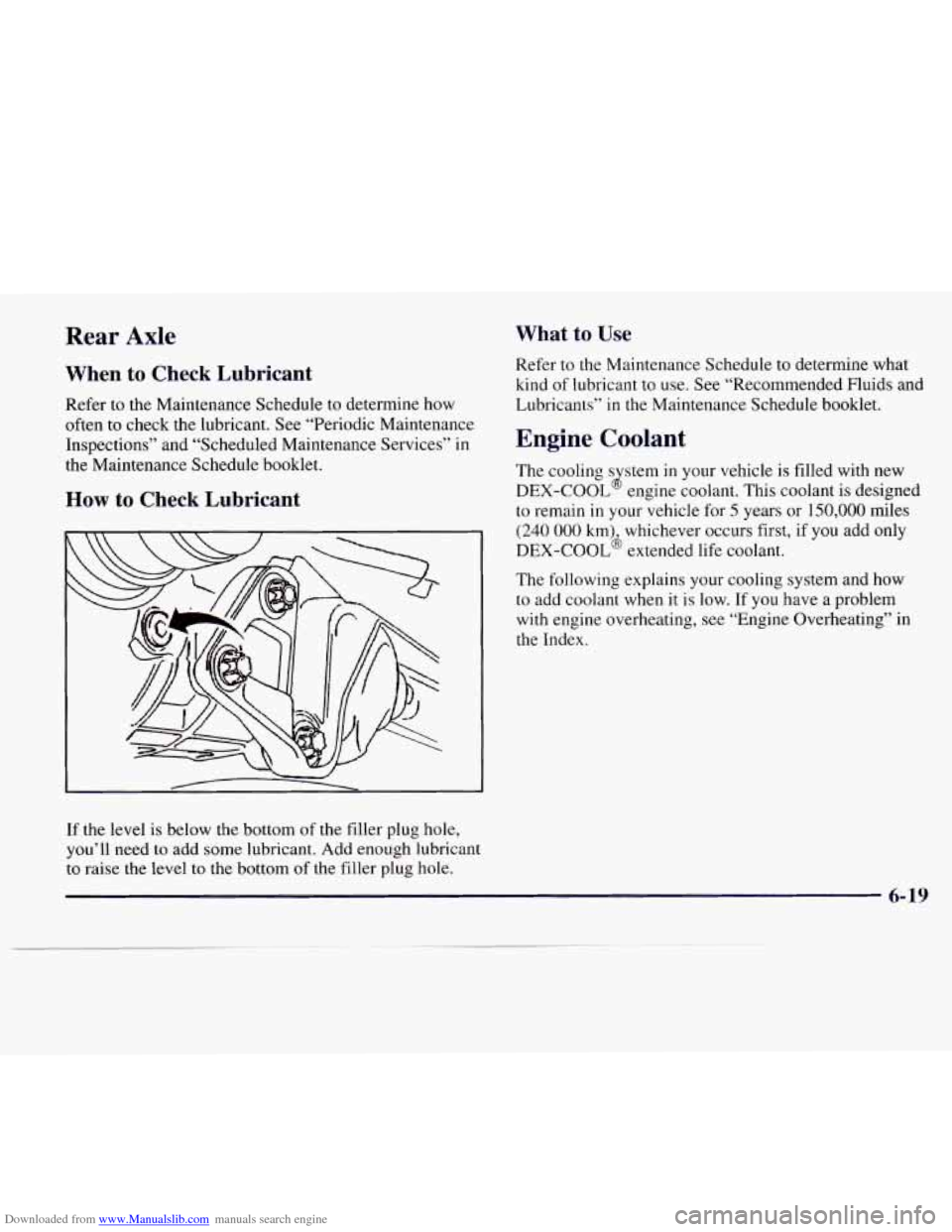
Downloaded from www.Manualslib.com manuals search engine Rear Axle
When to Check Lubricant
Refer to the Maintenance Schedule to determine how
often to check the lubricant. See “Periodic Maintenance
Inspections” and “Scheduled Maintenance Services” in
the Maintenance Schedule booklet.
How to Check Lubricant
I
What to Use
Refer to the Maintenance Schedule to determine what
kind
of lubricant to use. See “Recommended Fluids and
Lubricants” in
the Maintenance Schedule booklet.
Engine Coolant
The cooling s stem in your vehicle is filled with new
DEX-COOL
J engine coolant. This coolant is designed
to remain in your vehicle for
5 years or 150,000 miles
(240 000 km) whichever occurs first, if you add only
DEX-COOL6 extended life coolant.
The following explains your cooling system and how
to add coolant when it is low. If
you have a problem
with engine overheating, see “Engine Overheating” in
the Index.
If the level is below the bottom of the filler plug hole,
you’ll need
to add some lubricant. Add enough lubricant
to raise the level to the bottom of the filler plug hole.
6- 19
Page 264 of 338
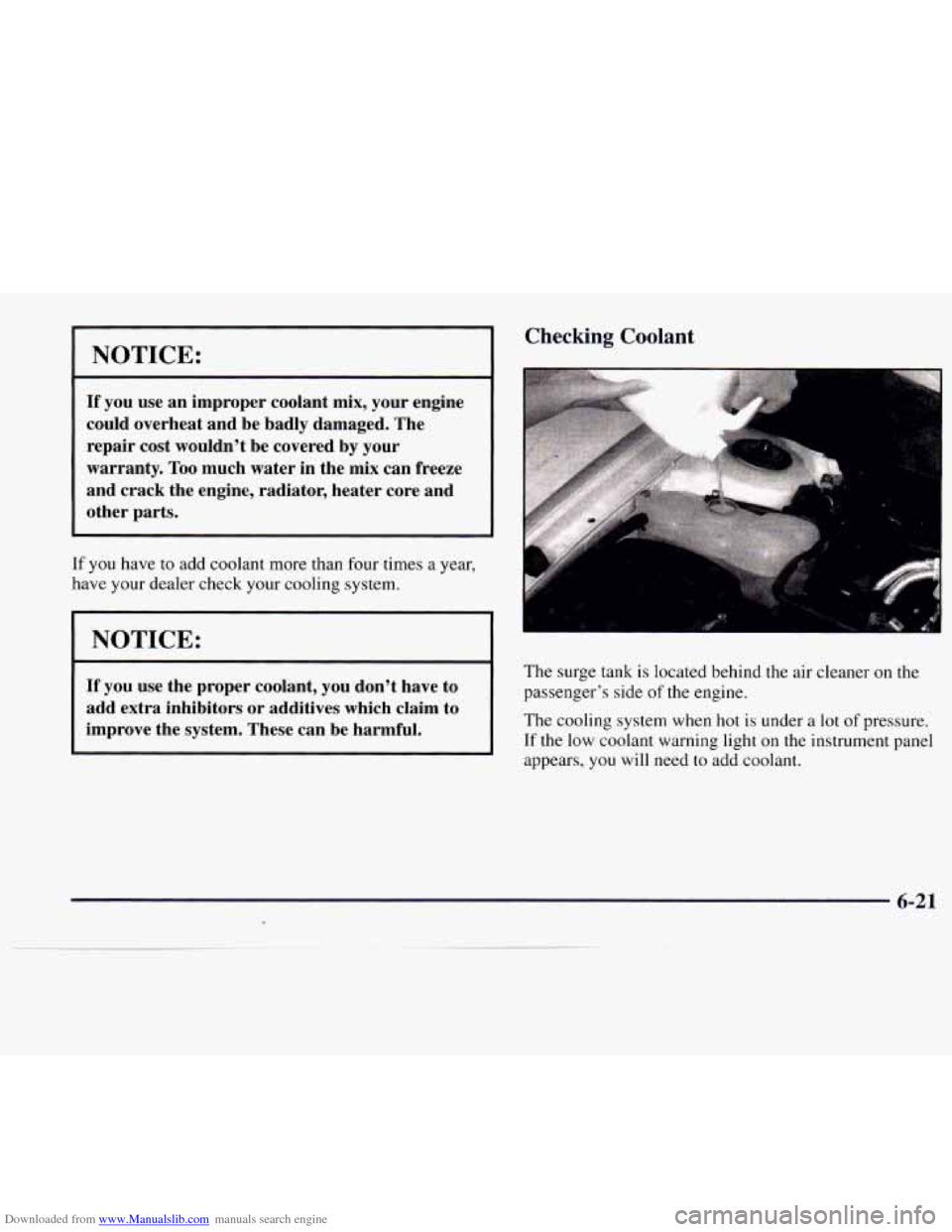
Downloaded from www.Manualslib.com manuals search engine NOTICE:
If you use an improper coolant mix, your engine
could overheat and be badly damaged. The
repair cost wouldn't be covered by your
warranty.
Too much water in the mix can freeze
and crack the engine, radiator, heater core and
other parts.
If you have to add coolant more than four times a year,
have your dealer check your cooling system.
NOTICE:
If you use the proper coolant, you don't have to
add extra inhibitors or additives which claim to
improve the system. These can be harmful.
Checking Coolant
The surge tank is located behind the air cleaner on the
passenger's side of the engine.
The cooling system when hot is under a lot of pressure.
If the low coolant warning light on the instrument panel
appears,
you will need to add coolant.
6-21
Page 266 of 338
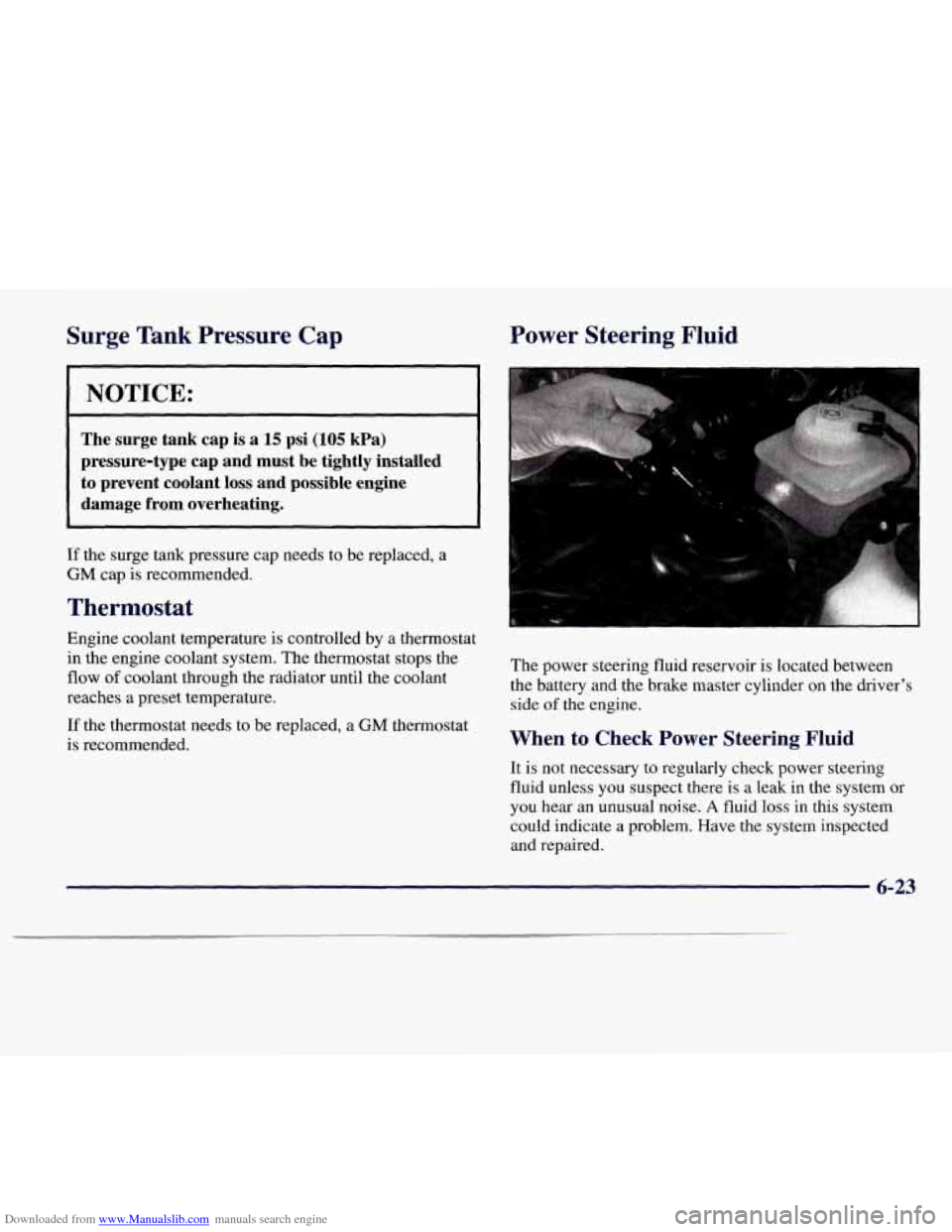
Downloaded from www.Manualslib.com manuals search engine Surge Tank Pressure Cap Power Steering Fluid
NOTICE:
The surge tank cap is a 15 psi (105 kPa)
pressure-type cap and must be tightly installed to prevent coolant loss and possible engine
damage from overheating.
If the surge tank pressure cap needs to be replaced, a
GM cap is recommended.
Thermostat
Engine coolant temperature is controlled by a thermostat
in the engine coolant system. The thermostat stops the
flow
of coolant through the radiator until the coolant
reaches a preset temperature.
If the thermostat needs to be replaced, a GM thermostat
is recommended. The
power steering fluid reservoir
is located between
the battery and the brake master cylinder on the driver’
side
of the engine.
When to Check Power Steering Fluid
It is not necessary to regularly check power steering
fluid unless you suspect there is a leak in the system or
you hear an unusual noise. A fluid loss in this system
could indicate a problem. Have the system inspected
and repaired.
6-23
Page 267 of 338
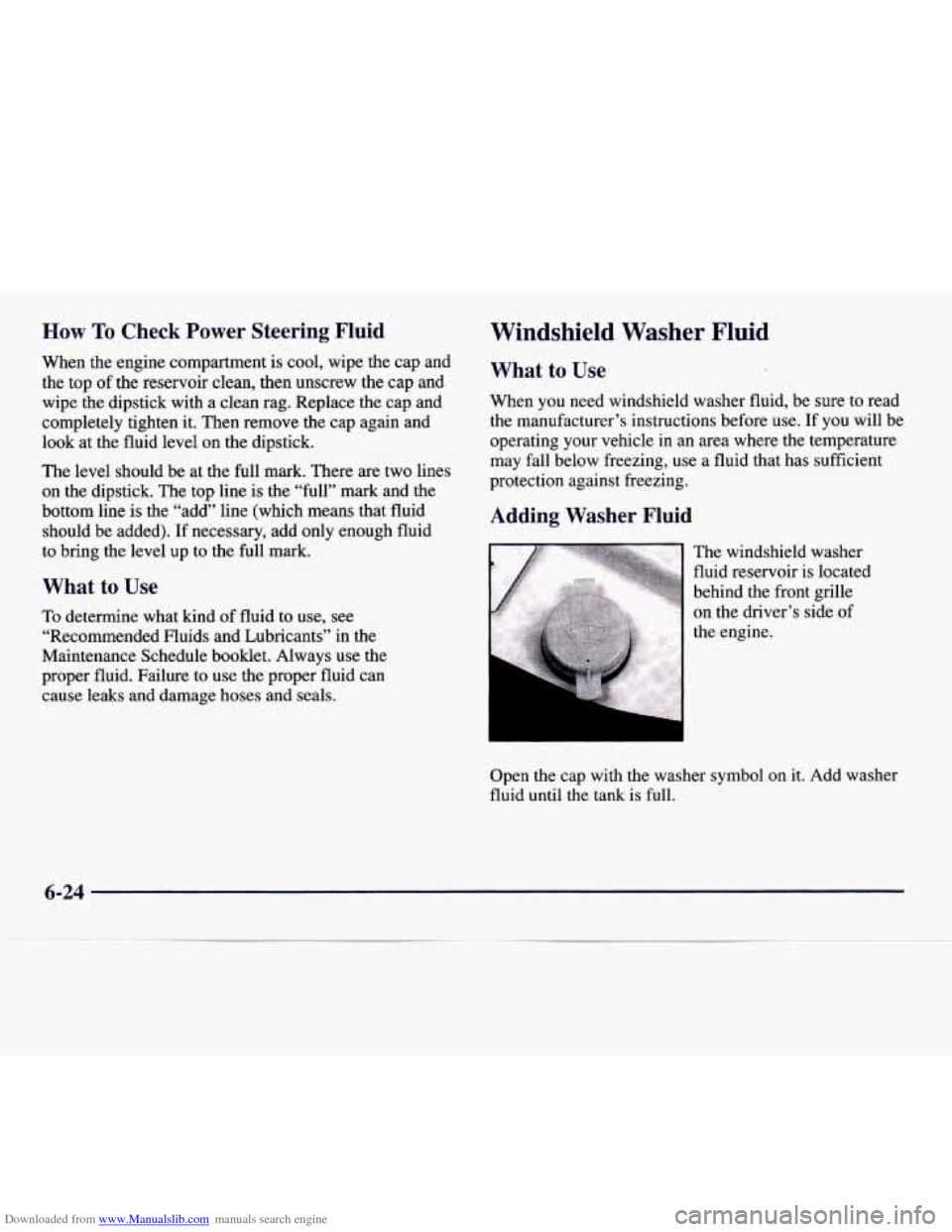
Downloaded from www.Manualslib.com manuals search engine Mow To Check Power Steering Fluid
When the engine compartment is cool, wipe the cap and
the top of the reservoir clean, then unscrew the cap and
wipe the dipstick with a clean rag. Replace the cap and
completely tighten it. Then remove the cap again and
look at the fluid level on the dipstick.
The level should be at the full mark. There are two lines
on the dipstick. The top line is the “full” mark and the
bottom
line is the “add” line (which means that fluid
should be added). If necessary, add only enough fluid
to bring the level up to the
full mark.
What to Use
To determine what kind of fluid to use, see
“Recommended Fluids and Lubricants” in the
Maintenance Schedule booklet. Always use the
proper fluid. Failure to use the proper fluid can
cause leaks and damage hoses and seals.
Windshield Washer Fluid
What to Use
When you need windshield washer fluid, be sure to read
the manufacturer’s instructions before use. If you will be
operating your vehicle
in an area where the temperature
may fall below freezing, use a fluid that has sufficient
protection against freezing.
Adding Washer Fluid
The windshield washer
fluid reservoir is located
behind the front grille
on the driver’s side
of
the engine.
Open the cap with the washer symbol on it. Add washer
fluid until
the tank is full.
6-24
Page 278 of 338
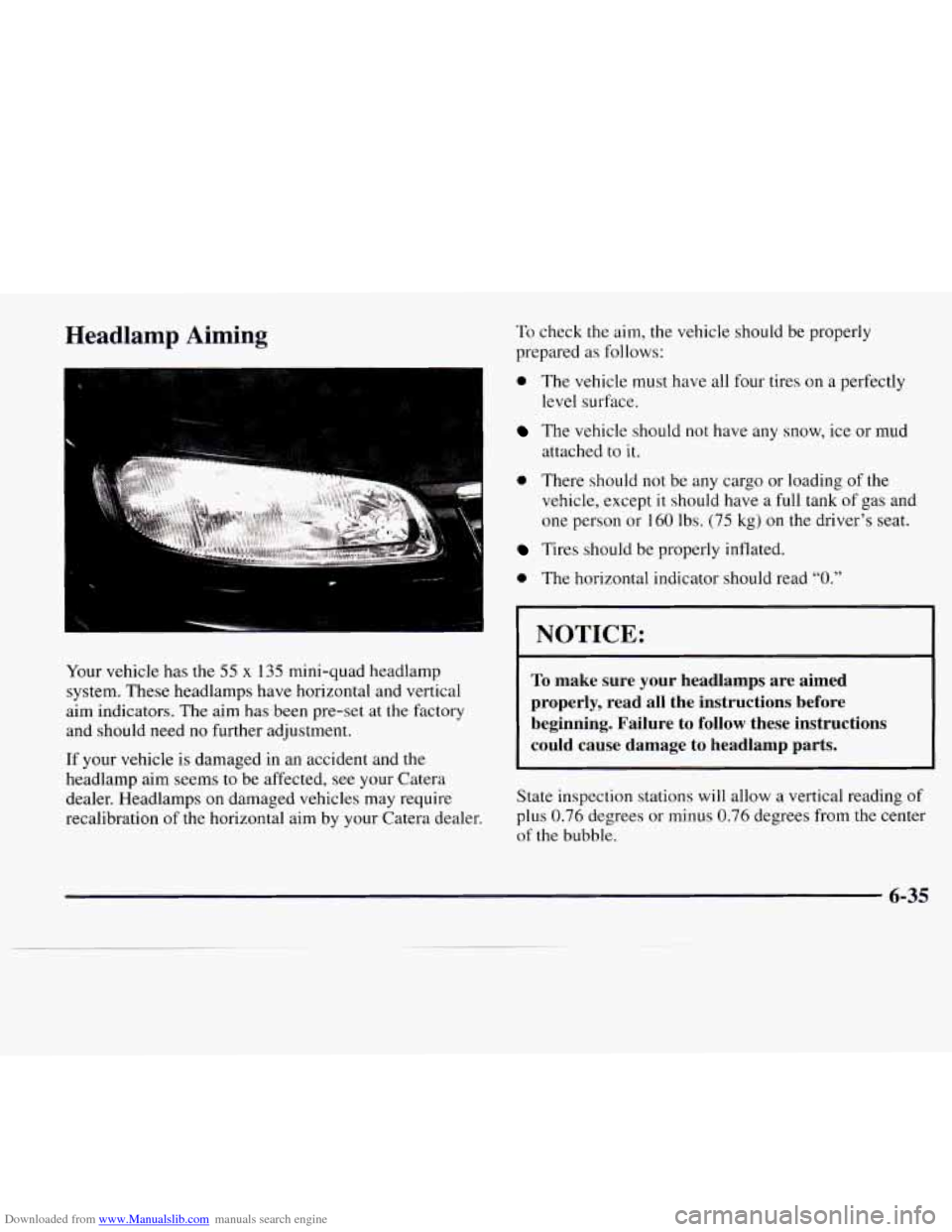
Downloaded from www.Manualslib.com manuals search engine Headlamp Aiming
Your vehicle has the 55 x 135 mini-quad headlamp
system. These headlamps have horizontal and vertical
aim indicators. The aim has been pre-set at the factory
and should need
no further adjustment.
If your vehicle is damaged in an accident and the
headlamp aim seems
to be affected, see your Catera
dealer. Headlamps on damaged vehicles may require
recalibration of the horizontal aim by your Catera dealer.
To check the aim, the vehicle should be properly
prepared as follows:
0 The vehicle must have all four tires on a perfectly
level surfxe.
The vehicle should not have any snow, ice or mud
attached to
it.
0 There should not be any cargo or loading of the
vehicle, except it should have a full tank
of gas and
one person or 160 lbs.
(75 kg) on the driver’s seat.
Tires should be properly inflated.
0 The horizontal indicator should read “0.”
NOTICE:
To make sure your headlamps are aimed
properly, read all the instructions before
beginning. Failure
to follow these instructions
could cause damage
to headlamp parts.
State inspection stations will allow a vertical reading of
plus
0.76 degrees or minus 0.76 degrees from the center
of the bubble.
6-35
Page 279 of 338

Downloaded from www.Manualslib.com manuals search engine It is recommended that the upper limit not exceed plus
0.4 degrees from the center of the bubble. Other drivers
may flash their high beams at you if your adjustment is
much above plus
0.4 degrees.
If you find that the headlamp aiming needs adjustment,
follow these steps: Adjustment screws can be turned with an
E8 Torx@
socket or a
TI 5 Torx screwdriver.
2. Check the vertical aim for each headlamp and adjust
it as necessary. You can see the level through the
headlamp assembly. Turn the vertical aiming screw,
on the outboard side of the headlamp assembly, until
the bubble in the level is centered at
0 (zero). 1. With a screwdriver, unscrew the fastener on the
headlamp cover and then remove the cover to be able
to
see the back of the headlamp assembly.
3. If the horizontal aim needs adjusting, see your
Catera dealer.
6-36
Page 281 of 338

Downloaded from www.Manualslib.com manuals search engine Tires
Your new Catera comes with high-quality tires made by
a leading tire manufacturer. If you ever have questions
about your tire warranty and where
to obtain service, see
your Catera Warranty booklet for details.
I
/! CAUTION:
Poorly maintained and improperly used tires
are dangerous.
0 Overloading your tires can cause overheating
as a result of too much friction. You could
have an airout and
a serious accident. See
“Loading Your Vehicle” in the Index.
0 Underinflated tires pose the same danger as
overloaded tires. The resulting accident
could cause serious injury. Check all tires
frequently to maintain the recommended
pressure. Tire pressure should be checked
when your tires are cold.
CAUTION: (Continued)
I--
@ Overinflated tires are more likely to be
cut, punctured or broken
by a sudden
impact
-- such as when you hit a pothole.
Keep tires at the recommended pressure.
0 Worn, old tires can cause accidents. If your
tread is badly worn, or
if your tires have
been damaged, replace them.
See “Inflation
-- Tire Pressure” in this section
for inflation pressure adjustment for higher
speed driving.
Inflation -- Tire Pressure
The Tire-Loading Information label, which is located
on the rear edge of the driver’s door, shows the correct
inflation pressures for your tires when they’re cold.
“Cold” means your vehicle has been sitting for
at least
three hours or driven
no more than 1 mile (1.6 km).
6-38
Page 282 of 338
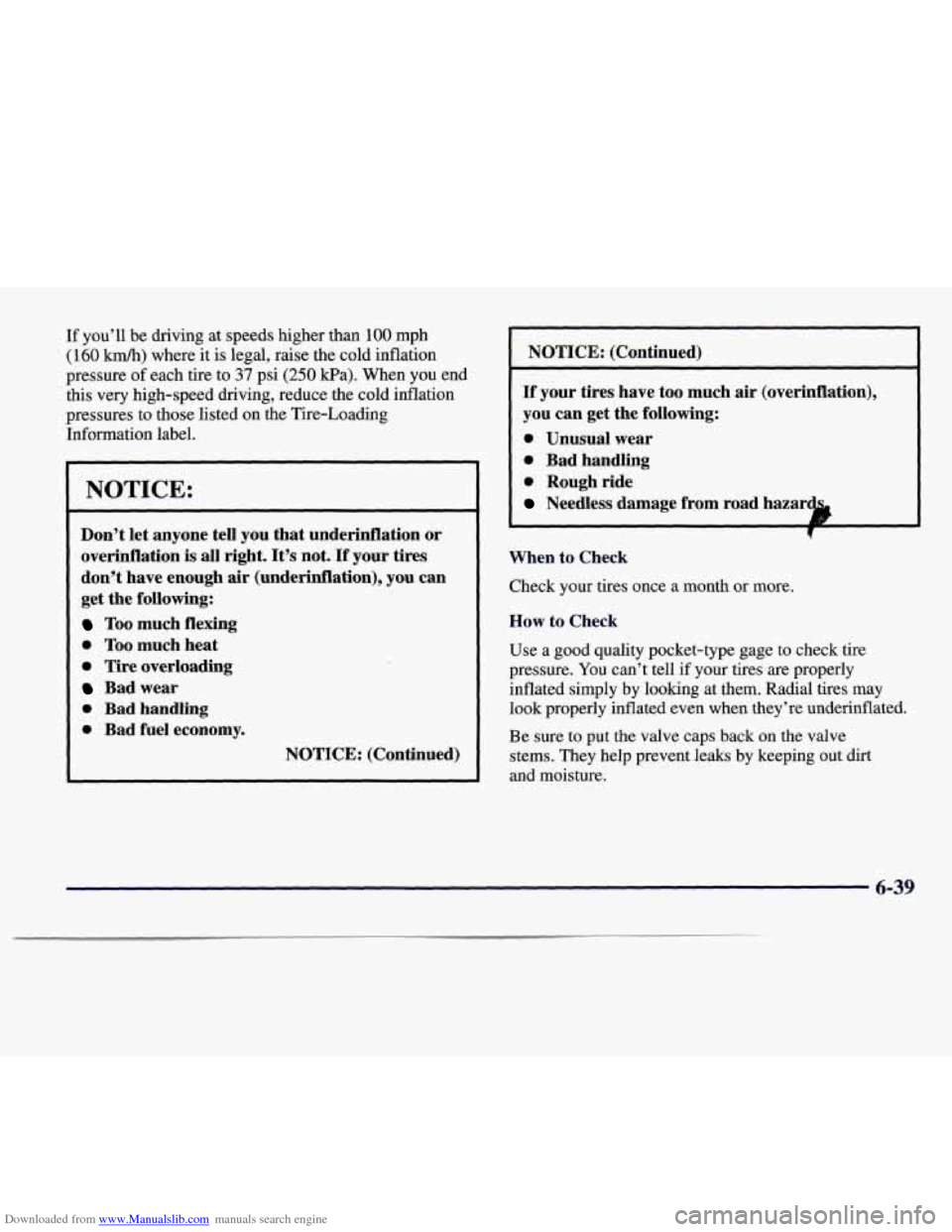
Downloaded from www.Manualslib.com manuals search engine If you’ll be driving at speeds higher than 100 mph
(160 km/h) where it is legal, raise the cold inflation
pressure of each tire to
37 psi (250 ma). When you end
this very high-speed driving, reduce the cold inflation
pressures to those listed on the Tire-Loading
Information label.
I NOTICE:
Don’t let anyone tell you that underinflation or
overinflation
is all right. It’s not. If your tires
don’t have enough air (underinflation), you can
get the following:
1 Too muchflexing
’ 0 Toomuch heat
~ 0 Tire overloading
Bad wear
0 Bad handling
1 0 Bad fuel economy.
NOTICE: (Continued)
I
NOTICE: (Continued) -
If your tires have too much air (overinflation),
you can get the following:
0 Unusual wear
0 Bad handling
0 Rough ride
Needless damage from road hazar
~- . - .. ..~ ~
v
When to Check
Check your tires once a month or more.
How to Check
Use a good quality pocket-type gage to check tire
pressure.
You can’t tell if your tires are properly
inflated simply
by looking at them. Radial tires may
look properly inflated even when they’re underinflated.
Be sure to put the valve caps back on the valve
stems. They help prevent leaks by keeping
out dirt
and moisture.
6-39
Page 283 of 338
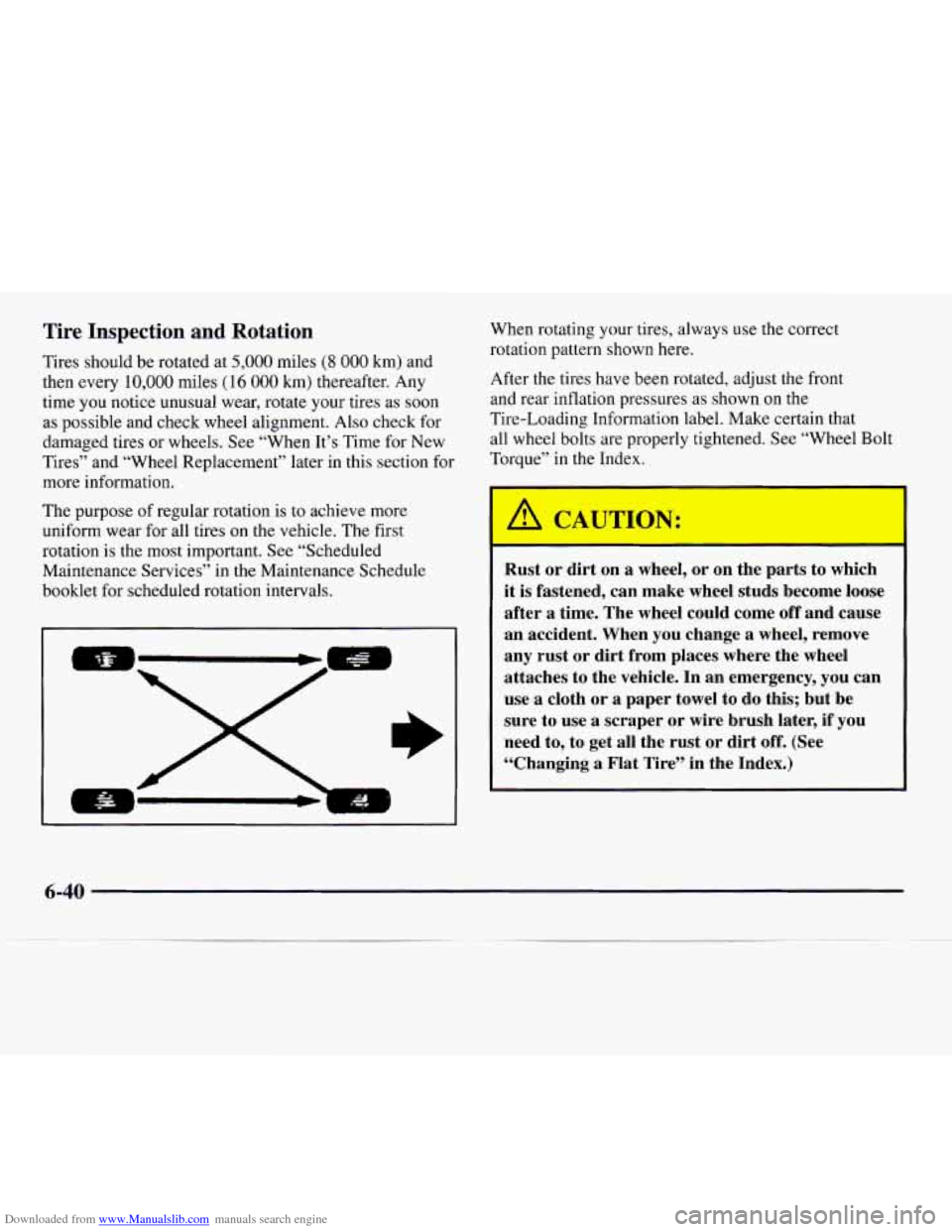
Downloaded from www.Manualslib.com manuals search engine Tire Inspection and Rotation
Tires should be rotated at 5,000 miles (8 000 km) and
then every
10,000 miles ( 16 000 km) thereafter. Any
time you notice unusual wear, rotate your tires as soon
as possible and check wheel alignment.
Also check for
damaged tires or wheels.
See “When It’s Time for New
Tires” and “Wheel Replacement” later in this section for
more information.
The purpose of regular rotation is to achieve more
uniform
wear for all tires on the vehicle. The first
rotation is the most important. See “Scheduled
Maintenance Services’’ in the Maintenance Schedule
booklet for scheduled rotation intervals. When rotating your tires,
always use the correct
rotation pattern shown here.
After the tires have been rotated, adjust the front
and rear inflation pressures as shown on the
Tire-Loading Information label. Make certain that all wheel bolts are properly tightened. See “Wheel Bolt
Torque”
in the Index.
Rust or dirt on a wheel, or on the parts to which
it is fastened, can make wheel studs become loose
after a time. The wheel could come off and cause
an accident. When you change
a wheel, remove
any rust or dirt from places where the wheel
attaches to the vehicle. In an emergency, you can
use a cloth or a paper towel to do this; but be
sure to use a scraper or wire brush later, if you
need to, to get all the rust or dirt off. (See
’ “Changing a Flat Tire” in the Index.)
6-40
Page 284 of 338

Downloaded from www.Manualslib.com manuals search engine When It’s Time for New Tires
One way to tell when it’s
time for new tires is to
check the treadwear
indicators, which will
appear when your tires have
only
1/16 inch (1.6 mm) or
less
of tread remaining.
You
need a new tire if any of the following statements
are true:
You can see the indicators at three or more places
around the tire.
You can see cord or fabric showing through the
tire’s rubber.
The tread or sidewall is cracked, cut or snagged
deep enough
to show cord or fabric.
0 The tire has a bump, bulge or split.
The tire has a puncture, cut or other damage that
can’t be repaired well because of the size or location
of the damage.
Buying New Tires
To find out what kind and size of tires you need, look at
the Tire-Loading Information label.
The tires installed
on your vehicle when it was new had
a Tire Performance Criteria Specification (TPC Spec)
number
on each tire’s sidewall. When you get new tires,
get ones with that same TPC Spec number. That way
your vehicle will continue to have tires that are designed
to give proper endurance, handling, speed rating,
traction, ride and other things during normal service on
your vehicle. If your tires have an all-season tread
design, the TPC number will be followed by an
“MS”
(for mud and snow).
If you ever replace your tires with those
not having a
TPC Spec number, make sure they are the same size,
load range, speed rating and construction type (bias,
bias-belted or radial) as your original tires.
6-41